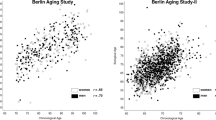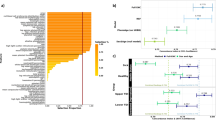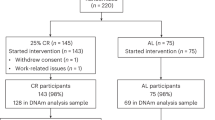Abstract
Methods to quantify biological aging are emerging as new measurement tools for epidemiology and population science and have been proposed as surrogate measures for healthy lifespan extension in geroscience clinical trials. Publicly available software packages to compute biological aging measurements from DNA methylation data have accelerated dissemination of these measures and generated rapid gains in knowledge about how different measures perform in a range of datasets. Biological age measures derived from blood chemistry data were introduced at the same time as the DNA methylation measures and, in multiple studies, demonstrate superior performance to these measures in prediction of healthy lifespan. However, their dissemination has been slow by comparison, resulting in a significant gap in knowledge. We developed a software package to help address this knowledge gap. The BioAge R package, available for download at GitHub (http://github.com/dayoonkwon/BioAge), implements three published methods to quantify biological aging based on analysis of chronological age and mortality risk: Klemera-Doubal biological age, PhenoAge, and homeostatic dysregulation. The package allows users to parametrize measurement algorithms using custom sets of biomarkers, to compare the resulting measurements to published versions of the Klemera-Doubal method and PhenoAge algorithms, and to score the measurements in new datasets. We applied BioAge to safety lab data from the CALERIE™ randomized controlled trial, the first-ever human trial of long-term calorie restriction in healthy, non-obese adults, to test effects of intervention on biological aging. Results contribute evidence that CALERIE intervention slowed biological aging. BioAge is a toolkit to facilitate measurement of biological age for geroscience.



Similar content being viewed by others
Data availability
All data used in this manuscript are publicly available. Data from the US National Health and Nutrition Examinations Surveys are available from the US Centers for Disease Control and Prevention at https://wwwn.cdc.gov/nchs/nhanes/Default.aspx. Data from the CALERIE trial are available from the CALERIE Research Network at https://calerie.duke.edu/samples-data-access-and-analysis.
Code availability
All the code used in these analyses is covered by GPL-3.0 License and is available from GitHub: https://github.com/dayoonkwon/BioAge.
References
Kirkwood TB. Understanding the odd science of aging. Cell. 2005;120(4):437–47. https://doi.org/10.1016/j.cell.2005.01.027.
Kennedy BK, Berger SL, Brunet A, Campisi J, Cuervo AM, Epel ES, et al. Geroscience: linking aging to chronic disease. Cell. 2014;159(4):709–13. https://doi.org/10.1016/j.cell.2014.10.039.
Lopez-Otin C, Blasco MA, Partridge L, Serrano M, Kroemer G. The hallmarks of aging. Cell. 2013;153(6):1194–217. https://doi.org/10.1016/j.cell.2013.05.039.
Campisi J, Kapahi P, Lithgow GJ, Melov S, Newman JC, Verdin E. From discoveries in ageing research to therapeutics for healthy ageing. Nature. 2019;571(7764):183–92. https://doi.org/10.1038/s41586-019-1365-2.
Kaeberlein M, Rabinovitch PS, Martin GM. Healthy aging: the ultimate preventative medicine. Science. 2015;350(6265):1191–3. https://doi.org/10.1126/science.aad3267.
Barzilai N, Cuervo AM, Austad S. Aging as a biological target for prevention and therapy. Jama-J Am Med Assoc. 2018;320(13):1321–2. https://doi.org/10.1001/jama.2018.9562.
Sierra F. Special issue: moving geroscience into uncharted waters: Guest Editorial Moving Geroscience Into Uncharted Waters. J Gerontol a-Biol. 2016;71(11):1385–7. https://doi.org/10.1093/gerona/glw087.
Ferrucci L, Gonzalez-Freire M, Fabbri E, Simonsick E, Tanaka T, Moore Z, et al. Measuring biological aging in humans: a quest. Aging Cell. 2020;19(2): e13080. https://doi.org/10.1111/acel.13080.
Justice J, Miller JD, Newman JC, Hashmi SK, Halter J, Austad SN, et al. Frameworks for proof-of-concept clinical trials of interventions that target fundamental aging processes. J Gerontol a-Biol. 2016;71(11):1415–23. https://doi.org/10.1093/gerona/glw126.
Moffitt TE, Belsky DW, Danese A, Poulton R, Caspi A. The longitudinal study of aging in human young adults: knowledge gaps and research agenda. J Gerontol A Biol Sci Med Sci. 2017;72(2):210–5. https://doi.org/10.1093/gerona/glw191.
Hannum G, Guinney J, Zhao L, Zhang L, Hughes G, Sadda S, et al. Genome-wide methylation profiles reveal quantitative views of human aging rates. Mol Cell. 2013;49(2):359–67. https://doi.org/10.1016/j.molcel.2012.10.016.
Horvath S. DNA methylation age of human tissues and cell types. Genome Biol. 2013;14(10):R115. https://doi.org/10.1186/gb-2013-14-10-r115.
Levine ME, Lu AT, Quach A, Chen BH, Assimes TL, Bandinelli S, et al. An epigenetic biomarker of aging for lifespan and healthspan. Aging (Albany NY). 2018;10(4):573–91. https://doi.org/10.18632/aging.101414.
Lu AT, Quach A, Wilson JG, Reiner AP, Aviv A, Raj K, et al. DNA methylation GrimAge strongly predicts lifespan and healthspan. Aging-Us. 2019;11(2):303–27. https://doi.org/10.18632/aging.101684.
Shireby GL, Davies JP, Francis PT, Burrage J, Walker EM, Neilson GWA, et al. Recalibrating the epigenetic clock: implications for assessing biological age in the human cortex. Brain. 2020;143:3763–75. https://doi.org/10.1093/brain/awaa334.
Weidner CI, Lin Q, Koch CM, Eisele L, Beier F, Ziegler P, et al. Aging of blood can be tracked by DNA methylation changes at just three CpG sites. Genome Biology. 2014;15(2). https://doi.org/10.1186/gb-2014-15-2-r24
Youn A, Wang S. The MiAge calculator: a DNA methylation-based mitotic age calculator of human tissue types. Epigenetics-Us. 2018;13(2):192–206. https://doi.org/10.1080/15592294.2017.1389361.
Zhang Q, Vallerga CL, Walker RM, Lin T, Henders AK, Montgomery GW, et al. Improved precision of epigenetic clock estimates across tissues and its implication for biological ageing. Genome Med. 2019;11(1). https://doi.org/10.1186/s13073-019-0667-1.
Horvath S, Raj K. DNA methylation-based biomarkers and the epigenetic clock theory of ageing. Nat Rev Genet. 2018;19(6):371–84. https://doi.org/10.1038/s41576-018-0004-3.
Belsky DW, Moffitt TE, Cohen AA, Corcoran DL, Levine ME, Prinz JA, et al. Eleven telomere, epigenetic clock, and biomarker-composite quantifications of biological aging: do they measure the same thing? Am J Epidemiol. 2018;187(6):1220–30. https://doi.org/10.1093/aje/kwx346.
Li X, Ploner A, Wang Y, Magnusson PK, Reynolds C, Finkel D, et al. Longitudinal trajectories, correlations and mortality associations of nine biological ages across 20-years follow-up. Elife. 2020;9. https://doi.org/10.7554/eLife.51507.
Murabito JM, Zhao Q, Larson MG, Rong J, Lin H, Benjamin EJ, et al. Measures of biologic age in a community sample predict mortality and age-related disease: the Framingham Offspring Study. J Gerontol A Biol Sci Med Sci. 2018;73(6):757–62. https://doi.org/10.1093/gerona/glx144.
Belsky DW, Caspi A, Cohen HJ, Kraus WE, Ramrakha S, Poulton R, et al. Impact of early personal-history characteristics on the pace of aging: implications for clinical trials of therapies to slow aging and extend healthspan. Aging Cell. 2017;16(4):644–51. https://doi.org/10.1111/acel.12591.
Hastings WJ, Shalev I, Belsky DW. Comparability of biological aging measures in the National Health and Nutrition Examination Study, 1999–2002. Psychoneuroendocrinology. 2019;106:171–8. https://doi.org/10.1016/j.psyneuen.2019.03.012.
Levine ME, Crimmins EM. Evidence of accelerated aging among African Americans and its implications for mortality. Soc Sci Med. 2014;118:27–32. https://doi.org/10.1016/j.socscimed.2014.07.022.
Shirazi TN, Hastings WJ, Rosinger AY, Ryan CP. Parity predicts biological age acceleration in post-menopausal, but not pre-menopausal, women. Sci Rep-Uk. 2020;10(1). https://doi.org/10.1038/s41598-020-77082-2.
Klemera P, Doubal S. A new approach to the concept and computation of biological age. Mech Ageing Dev. 2006;127(3):240–8. https://doi.org/10.1016/j.mad.2005.10.004.
Cohen AA, Milot E, Yong J, Seplaki CL, Fulop T, Bandeen-Roche K, et al. A novel statistical approach shows evidence for multi-system physiological dysregulation during aging. Mech Ageing Dev. 2013;134(3–4):110–7. https://doi.org/10.1016/j.mad.2013.01.004.
Levine ME. Modeling the rate of senescence: can estimated biological age predict mortality more accurately than chronological age? J Gerontol a-Biol. 2013;68(6):667–74. https://doi.org/10.1093/gerona/gls233.
Belsky DW, Caspi A, Houts R, Cohen HJ, Corcoran DL, Danese A, et al. Quantification of biological aging in young adults. Proc Natl Acad Sci USA. 2015;112(30):E4104–10. https://doi.org/10.1073/pnas.1506264112.
Belsky DW, Huffman KM, Pieper CF, Shalev I, Kraus WE. Change in the rate of biological aging in response to caloric restriction: CALERIE Biobank Analysis. J Gerontol A Biol Sci Med Sci. 2017;73(1):4–10. https://doi.org/10.1093/gerona/glx096.
Levine ME, Crimmins EM. Is 60 the new 50? Examining changes in biological age over the past two decades. Demography. 2018;55(2):387–402. https://doi.org/10.1007/s13524-017-0644-5.
Li Q, Wang S, Milot E, Bergeron P, Ferrucci L, Fried LP, et al. Homeostatic dysregulation proceeds in parallel in multiple physiological systems. Aging Cell. 2015;14(6):1103–12. https://doi.org/10.1111/acel.12402.
Liu Z, Kuo PL, Horvath S, Crimmins E, Ferrucci L, Levine M. A new aging measure captures morbidity and mortality risk across diverse subpopulations from NHANES IV: a cohort study. PLoS Med. 2018;15(12): e1002718. https://doi.org/10.1371/journal.pmed.1002718.
Cohen AA. Complex systems dynamics in aging: new evidence, continuing questions. Biogerontology. 2016;17(1):205–20. https://doi.org/10.1007/s10522-015-9584-x.
Mahalanobis PC. Mahalanobis distance. Proceedings of the National Academy of Sciences, India. 1936;73:1370–6.
Parker DC, Bartlett BN, Cohen HJ, Fillenbaum G, Huebner JL, Kraus VB, et al. Association of blood chemistry quantifications of biological aging with disability and mortality in older adults. J Gerontol A Biol Sci Med Sci. 2019. https://doi.org/10.1093/gerona/glz219.
Levine ME. Modeling the rate of senescence: can estimated biological age predict mortality more accurately than chronological age? J Gerontol A Biol Sci Med Sci. 2013;68(6):667–74. https://doi.org/10.1093/gerona/gls233.
Ingram DD, Lochner KA, Cox CS. Mortality experience of the 1986–2000 National Health Interview Survey Linked Mortality Files participants. Vital Health Stat 2. 2008, (147):1–37.
Ravussin E, Redman LM, Rochon J, Das SK, Fontana L, Kraus WE, et al. A 2-year randomized controlled trial of human caloric restriction: feasibility and effects on predictors of health span and longevity. J Gerontol A Biol Sci Med Sci. 2015;70(9):1097–104. https://doi.org/10.1093/gerona/glv057.
Kraus WE, Bhapkar M, Huffman KM, Pieper CF, Krupa Das S, Redman LM, et al. 2 years of calorie restriction and cardiometabolic risk (CALERIE): exploratory outcomes of a multicentre, phase 2, randomised controlled trial. Lancet Diabetes Endocrinol. 2019;7(9):673–83. https://doi.org/10.1016/S2213-8587(19)30151-2.
Gladyshev VN. The ground zero of organismal life and aging. Trends Mol Med. 2021;27(1):11–9. https://doi.org/10.1016/j.molmed.2020.08.012.
Graf G, Crowe C, Kothari M, Kwon D, Manly J, Turney I, et al. Testing DNA-methylation and blood-chemistry measures of biological aging in models of Black-White disparities in healthspan characteristics. medRxiv. 2021:2021.03.02.21252685. https://doi.org/10.1101/2021.03.02.21252685.
Liu Z, Chen X, Gill TM, Ma C, Crimmins EM, Levine ME. Associations of genetics, behaviors, and life course circumstances with a novel aging and healthspan measure: evidence from the Health and Retirement Study. PLoS Med. 2019;16(6): e1002827. https://doi.org/10.1371/journal.pmed.1002827.
Parker DC, Bartlett BN, Cohen HJ, Fillenbaum G, Huebner JL, Kraus VB, et al. Association of blood chemistry quantifications of biological aging with disability and mortality in older adults. J Gerontol A Biol Sci Med Sci. 2020;75(9):1671–9. https://doi.org/10.1093/gerona/glz219.
Funding
This work was supported by the National Institute on Aging grants R01AG061378 and R01AG066887 and Russel Sage Foundation BioSS grant 1810–08987. DWB is a fellow of the Canadian Institute for Advanced Research Child Brain Development Network.
Author information
Authors and Affiliations
Contributions
DWB and DK conceived the research and designed the software and analysis. DK wrote the software, conducted the analysis, and produced the figures. DWB and DK wrote the manuscript. Both authors had access to the data.
Corresponding author
Ethics declarations
Ethics approvals
Not applicable.
Consent to participant
Not applicable.
Consent for publication
Not applicable.
Competing interests
The authors declare no competing interests.
Additional information
Publisher's note
Springer Nature remains neutral with regard to jurisdictional claims in published maps and institutional affiliations.
Supplementary Information
Below is the link to the electronic supplementary material.
About this article
Cite this article
Kwon, D., Belsky, D.W. A toolkit for quantification of biological age from blood chemistry and organ function test data: BioAge. GeroScience 43, 2795–2808 (2021). https://doi.org/10.1007/s11357-021-00480-5
Received:
Accepted:
Published:
Issue Date:
DOI: https://doi.org/10.1007/s11357-021-00480-5




